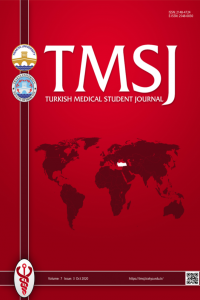Abstract
References
- 1. Carney EF. The impact of chronic kidney disease on global health. Nat Rev Nephrol 2020;16(5):251.
- 2. Rambod M, Shabani M, Shokrpour N et al. Quality of life of he- modialysis and renal transplantation patients. Health Care Manag 2011;30(1):23-8.
- 3. Jung HY, Jeon Y, Park Y et al. Better quality of life of peritoneal dialysis compared to hemodialysis over a two-year period afterdialysis initiation. Sci Rep 2019;9(1):10266.
- 4. Ng JK, Li PK. Chronic kidney disease epidemic: How do we deal with it? Nephrology 2018;23(4):116-20.
- 5. Li H, Xie L, Yang J et al. Symptom burden amongst patients suffering from end-stage renal disease and receiving dialysis: A literature review. Int J Nurs Sci 2018;5(4):427-31.
- 6. Ricardo AC, Yang W, Sha D et al. Sex-related disparities in CKD progression. J Am Soc Nephrol 2019;30(1):137-46.
- 7. de Sequera P, Corchete E, Bohorquez L et al. Residual renal function in hemodialysis and inflammation. Ther Apher Dial 2017;21(6):592-8.
Abstract
Aims: This study investigates the relationship between the clinical parameters at the beginning of hemodialysis therapy and the changing in the frequency of weekly hemodialysis sessions in ongoing treatment. Methods: The study population was composed of all of the patients that were started chronic hemodialysis treatment between January 2015 and January 2020. The patients were classified as twice-weekly (2/7) and thrice-weekly (3/7) groups according to the hemodialysis schedule at the start of treat- ment. The 3/7 group is additionally subdivided according to the dialysis schedule switches to the thrice-weekly program. Basal demographics and biochemical parameters were obtained from medical records at the start of hemodialysis. Results: The total number of subjects in the study was 433 (141 in the twice-weekly program, 292 in the thrice-weekly program). Forty-six (32.6%) patients in twice-weekly hemodialysis program were shifted to a thrice-weekly program during the follow-up. The female/ male ratio in the 2/7 program is different from the 3/7 program. Serum creatinine and C-reactive protein levels were higher in patients on the 3/7 program. Serum calcium and albumin levels were higher in patients on a 2/7 program. The statistically sig- nificant increments were found in calcium, hemoglobin, hematocrit, urea, creatinine, and potassium levels between the before and after switch results of the 3/7 group which switched from 2/7. Conclusion: Urea, creatinine, and potassium levels can guide the decision to compose a hemodialysis schedule. However, patients' future weekly treatment schedules cannot be predicted by biochemical parameters obtained at the start of hemodialysis.
References
- 1. Carney EF. The impact of chronic kidney disease on global health. Nat Rev Nephrol 2020;16(5):251.
- 2. Rambod M, Shabani M, Shokrpour N et al. Quality of life of he- modialysis and renal transplantation patients. Health Care Manag 2011;30(1):23-8.
- 3. Jung HY, Jeon Y, Park Y et al. Better quality of life of peritoneal dialysis compared to hemodialysis over a two-year period afterdialysis initiation. Sci Rep 2019;9(1):10266.
- 4. Ng JK, Li PK. Chronic kidney disease epidemic: How do we deal with it? Nephrology 2018;23(4):116-20.
- 5. Li H, Xie L, Yang J et al. Symptom burden amongst patients suffering from end-stage renal disease and receiving dialysis: A literature review. Int J Nurs Sci 2018;5(4):427-31.
- 6. Ricardo AC, Yang W, Sha D et al. Sex-related disparities in CKD progression. J Am Soc Nephrol 2019;30(1):137-46.
- 7. de Sequera P, Corchete E, Bohorquez L et al. Residual renal function in hemodialysis and inflammation. Ther Apher Dial 2017;21(6):592-8.
Details
| Primary Language | English |
|---|---|
| Subjects | Clinical Sciences |
| Journal Section | Research Article |
| Authors | |
| Publication Date | October 31, 2020 |
| Submission Date | May 30, 2020 |
| Published in Issue | Year 2020 Volume: 7 Issue: 3 |


